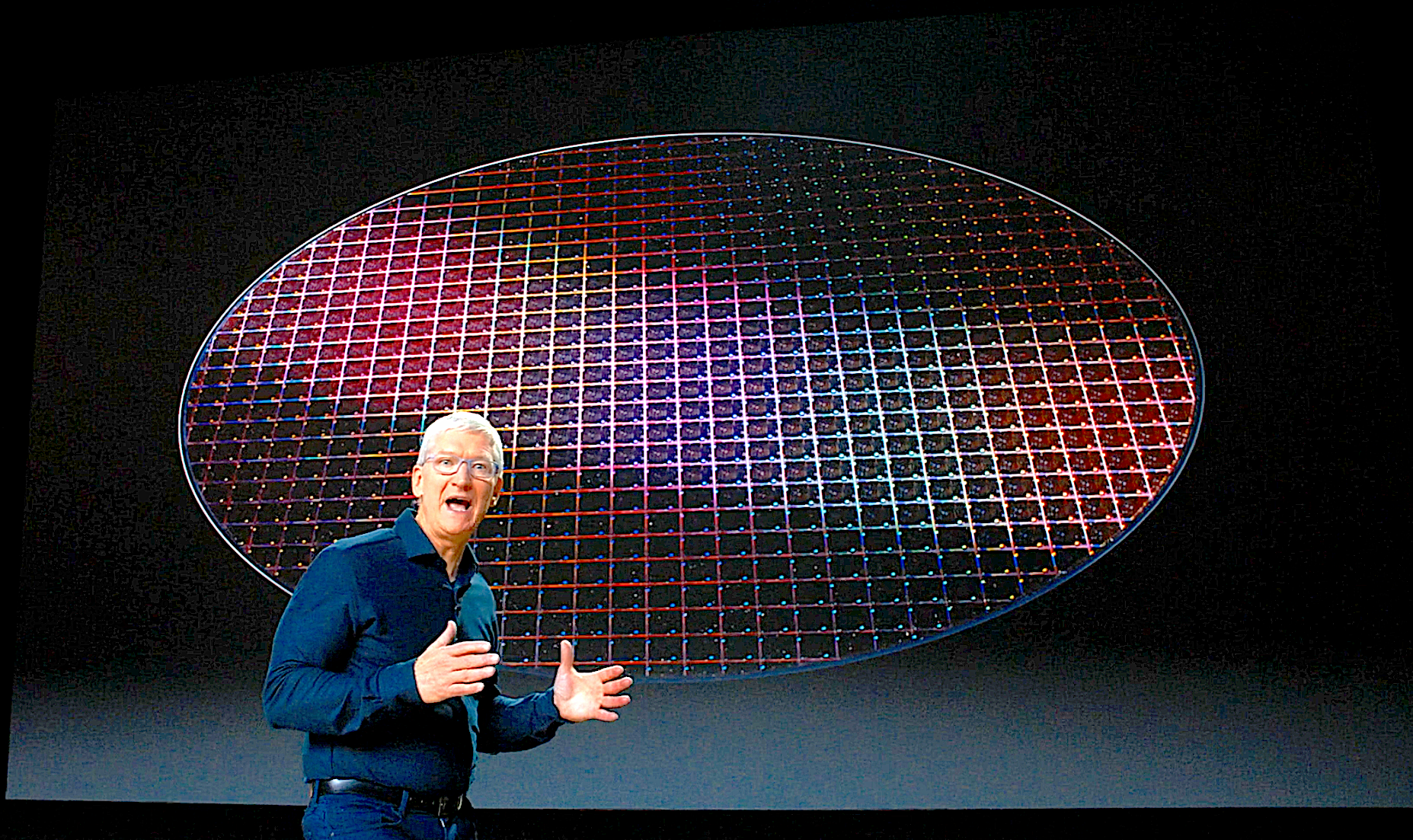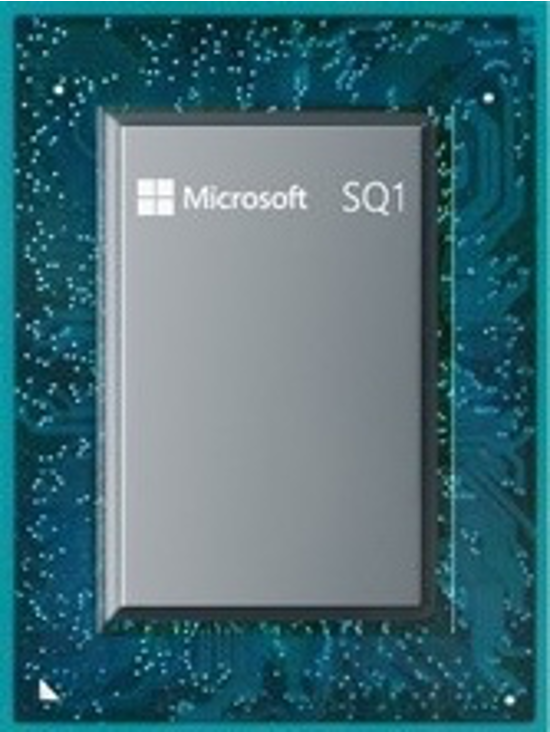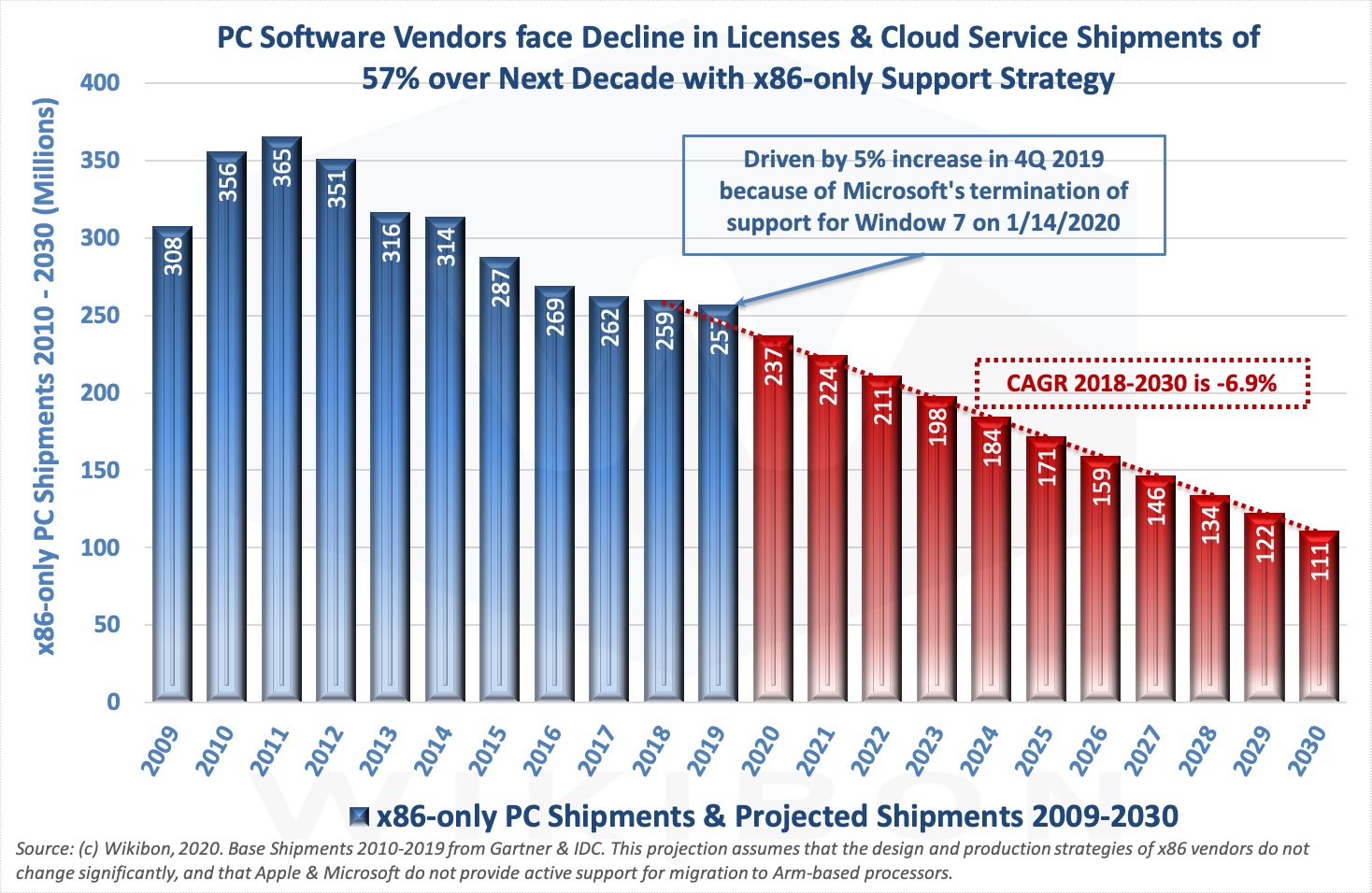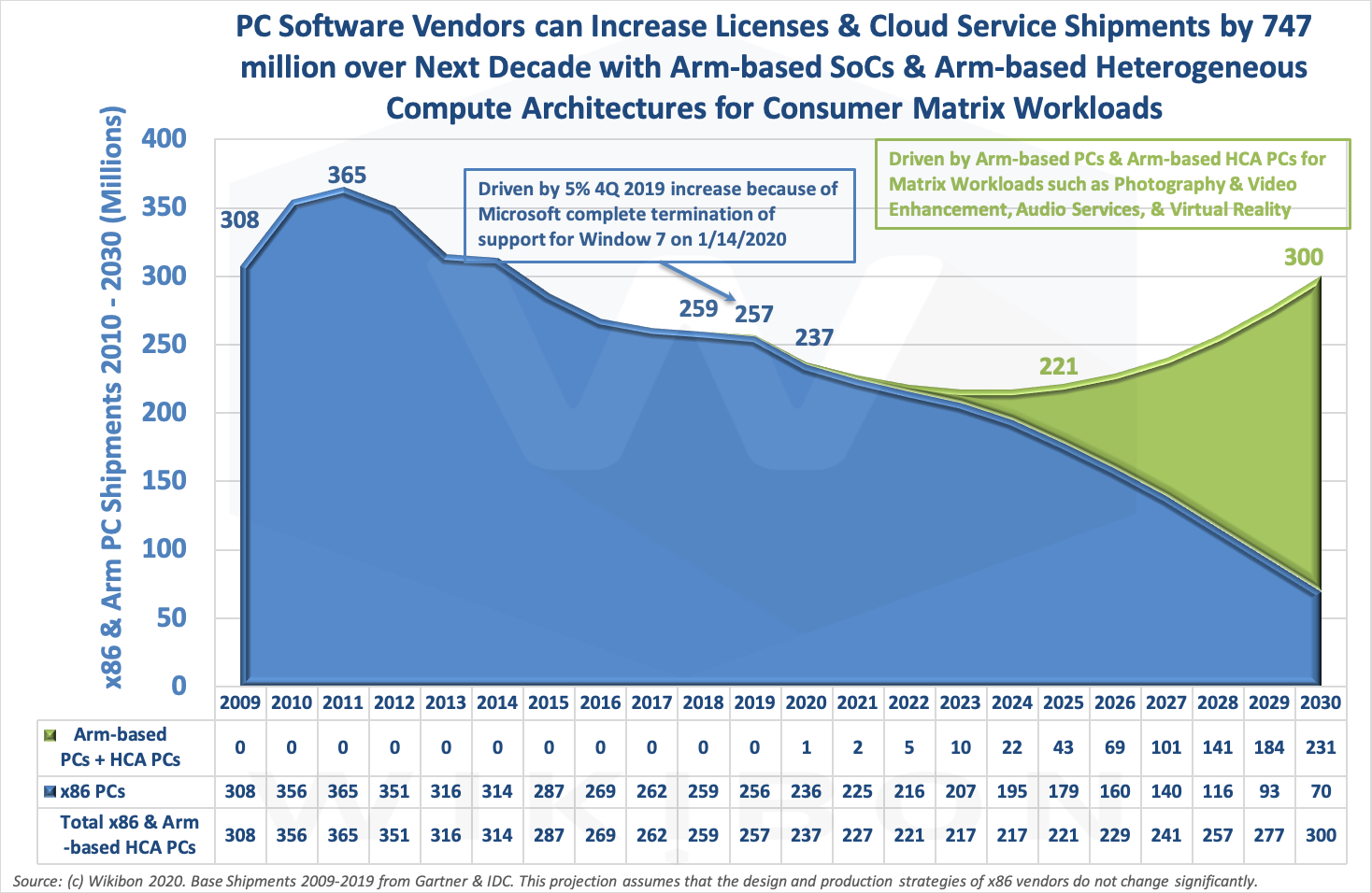 INFRA
INFRA
 INFRA
INFRA
 INFRA
INFRA
In a sea change, Apple Inc. and Microsoft Corp. are exiting Intel Corp.’s x86 processor architecture for their personal computers.
Apple has been using x86 for 15 years, Microsoft for more than 30 years. Apple Chief Executive Tim Cook (pictured) announced the transition to the Arm Ltd.-based PC for the macOS at its online Worldwide Developers Conference this week and said it would complete the process by 2021. Microsoft is also investing in Arm-based PC chips and PCs for Windows and is planning to remove the software migration barriers by 2021.
The primary reasons for this transition are lower costs, a reduction in power requirements and a common platform enabling applications to run on smartphones, tablets and PCs. In turn, this universal platform will enable faster adoption of software and hardware innovations and lead to higher productivity for the end-users.
Both Apple and Microsoft want to reverse the steady decline in PC shipments and see PC growth again. Both want to sell additional software and services to the Arm-based PC, though both platforms will be supporting x86 PCs for a long time.
Any transition is a big and risky business decision. However, our research concludes that the likely benefits of moving are worth the transition execution risk for Apple and Microsoft. Wikibon, SiliconANGLE’s sister market research firm, projects an initial gradual adoption of the Arm-based PC, accelerating over the rest of the decade. Also, Wikibon sees a significant increase in overall PC shipments over the second half of this decade.
At the moment, an Arm-based PC can be faster than an x86 PC and has significantly lower power requirements. Also, it can employ advanced architectures and technologies. These advances enable an Arm-based PC, for example, to process inference AI two orders of magnitude times faster than a traditional x86 PC.
These factors will lead to a sleeker and more powerful Arm-based PC with better battery life. The Apple and Windows PC platforms will become a high-end extension of the smartphone and tablet platforms. They will offer more functions and have access to a broader array of applications.
Apple and Microsoft are investing substantially in the software migration to the Arm-based PC. This code includes AI inference, virtual reality and significant enhancements to real-time photography, video and audio. Wikibon projects that Arm-based PC shipments will increase significantly over the second half of this decade to about 300 million PCs shipped annually by the end of the decade. Wikibon believes the Arm-based PC will make users more productive.
There are two important caveats to this projection: This assumes that x86 vendors do not change their design and manufacturing strategies significantly during the early part of this decade and that Apple and Microsoft continue to invest aggressively in the Arm-based PC and its software ecosystem.
In 1990 about 20 million PCs were shipped, and shipments increased by about 15% every year until PC shipments reached their zenith in 2011. Figure 2 below shows that 365 million PCs shipped in 2011. The “Wintel” duopoly of Intel and Microsoft improved the performance and price-performance of Intel chips every eighteen months, and the functionality of Microsoft Windows with new releases 3-4 years. Windows became the de facto base for both consumer PC applications such as gaming and business applications such as Lotus 123, later usurped by Excel.
Over this growth period, Microsoft was able to integrate a layer of business productivity tools into Microsoft Office and became a software leviathan. Microsoft developed NT, which allowed the same Windows base to be available for servers and PCs. Slowly Intel and Microsoft increased the functions and speed of servers against the reduced instruction-set computing or RISC vendors from the bottom up.
Linus Torvalds created open-source Linux in 1991, and it rapidly became a standard operating system for servers. Red Hat offers maintenance and update services. The functionality and platforms supported by Linux snowballed. Microsoft Windows Server was the looser. In March 2003, the SCO Group, funded by Microsoft, accused IBM of violating its copyright on UNIX. Microsoft’s objective was to outlaw all open-source code. Open-source won in court and in information technology departments.
Linux became the base for most developers. Apple used it with the Arm processors at the historic announcement of the iPod Nano in 2006. Two years later, it became the underlying iOS in the iPhone. Google used Linux and Arm processors for Android development, and Linux was on its way to dominating the consumer and device markets.
When Amazon Web Services Inc.started, it used open-source software and Linux as the basis for building the AWS platform. When Microsoft invested seriously in cloud computing, Satya Nadella, in his role as cloud director and subsequently as chief executive starting in 2014, brought in Linux as a primary operating system.
The Intel-Microsoft duopoly split apart in servers, with Intel becoming the winner in more than 90% of servers. In PCs, it has held together. However, PCs have been declining steadily since 2011. The question is why.
2008 was the year of the iPhone. Sales of smartphones exploded. Consumer and enterprise budgets, data and user time migrated to smartphones and tablets. Time spent on the PC and online with a PC declined as Arm-based systems became more sophisticated through continuous improvement. The time between new PC purchases became higher, and the innovations in PC operating system releases became fewer.
After former CEO Steve Ballmer’s one Microsoft, Satya Nadella made it clear that each Microsoft product line has to stand on its own. His first announcement when he took over in 2014 was to release Microsoft Office support on Apple iOS and move it to a continuous subscription model with OS365. That soon extended to every OS, and Windows lost its monopoly of Microsoft Office.
At the same time, Windows 10 came with a continuous improvement model – the last Windows version. The combination of Windows 10 and pricing pressure on PC manufacturers prevented Linux from establishing a PC foothold.
However, Windows 10 has not been sufficient to stop the reduction in PC volumes. Every year since 2011, eight years in a row, shipment annual growth rates have declined by a little over 4%. There are wild celebrations when a quarter shows positive growth. For example, the fourth-quarter of 2019 grew 5%, driven by Microsoft’s termination of support for Windows 7 on 11th January 2020.
The boost lasted one quarter before the first quarter of 2020, when shipments declined quarter-over-quarter by over 9%. The press and analysts have made many PC forecasts that a new age of PCs was on the horizon. Microsoft has driven many PC marketing campaigns but to no avail.
The volume of Arm-based processors shipped is 10 times greater than x86 processors. This fact, together with the disaggregation of Arm-based processor production from design, has led to the processor fabrication companies leading Intel by at least two generations. Apple will move to five-nanometer process production in 2020, whereas most x86 PC shipments are on 10- or 14-nanometer. As a result, Arm-processors have higher performance, lower costs, lower energy requirements and better functionality.
Apple operates at the high end of the PC market. In 2019, Apple shipped 18 million PCs, up 6.9%) Its revenue was $22.9 billion, up 13.5%, at an average selling price of over $1,200 per PC. The average selling price, excluding Apple, was $460 per PC.
At WWDC Monday, Cook announced that Apple would migrate to the Arm-based PC over the next two years. The Arm-based SoCs are the same Apple-designed family that drives the iPhone and iPads. A benefit of the Arm-based PC is much lower power for the same performance, which allows either more compute power, extended battery life, sleeker PCs or a combination.
The Arm-based processors also can include Heterogeneous Compute architectures to tackle AI inference applications such as real-time photographic improvements, real-time movie rendering and real-time audio enhancements.
Perhaps the most exciting capability is virtual reality using the consumer volume ultraviolet and infrared scanners, Time of Flight (ToF) sensors and specialized Arm-based hardware. This combination has the potential to change virtual reality from headache-inducing awfulness to a truly immersive experience.
Lastly, using Arm-based technologies makes it possible to have all the iPhone and iPad applications run on the Mac PC, with the ability to have a continuous connection with WiFi and 4G LTE, and eventually with 5G. Can you imagine Gen Z accepting anything less?

Microsoft has a small share of the PC market at $6.8 billion. However, it’s the largest software and services supplier to the PC market. The driving force behind Microsoft’s push for the Arm-based PC is to turn the PC from a declining market to an expanding market and therefore grow its PC software and services revenue.
Microsoft shares a similar objective to Apple. It wants to move its current PC platform to Arm-based processors that offer better price-performance, constant connectivity and improved architectures for real-time Matrix applications. Also, it wants Windows to run the Arm-based applications that are currently running on iOS and Android platforms.
In 2020, Microsoft introduced the Surface Pro X with the Microsoft SQ1 processor, based on the Qualcomm Snapdragon 8cx SoC. The performance reports are good, the LTE connection excellent, and the all-day battery-life compelling. However, software support is still a work in progress. Microsoft has been straightforward about these deficiencies:
These deficiencies are also a roadmap to full Windows support of Arm-based processors. Microsoft seems committed to making it happen, both with programmers and perhaps with special software pricing to encourage new Arm-based PC vendors.
Microsoft’s work with Qualcomm has led to lower-powered and lower cost Qualcomm SoCs, such as the 8c and the 7c SoCs. These processors will allow PC vendors to develop an entry-level Arm-based PC.
Microsoft will need to add features to support advanced Heterogeneous Compute architectures that will enable Matrix Workloads to be run on PCs. The Matrix workloads will include real-time inference AI for virtual reality. photography and video enhancements and the like. Like Apple, Microsoft will make this functionality available on x86 PCs, with lower performance expectations.
Based on the Apple and Microsoft strategies, Wikibon has projected two PC scenarios.
Figure 2 below shows the Wikibon projection for PC shipments without active support from Apple and Microsoft in an x86-only scenario:

Figure 2’s y axis shows the number of PCs shipped each year from 2009 – 2019 as blue columns on the x axis. Wikibon projects that x86 PC shipments will continue to decline at 6.9% from 2020 to 2030. There are two assumptions in this projection:
Both Apple and Microsoft are significant providers of software and services for their PC platforms, and increasing the shipment of PCs would turn around the expected decline in software licenses and cloud services. This outcome is of great importance to both companies, and especially to Microsoft, with its dominance of Windows in the PC market. That takes us to the second scenario.
Figure 3 shows the Wikibon projection assuming active support from Apple and Microsoft to migrate iOS and Windows to support Arm-based processors. Also, they will help ISVs move the top 10% of applications to run well on Arm-supported OSes, and provide emulation features to enable most applications to work.

Figure 3’s y axis shows the number of x86-based PC shipments in blue and the Arm-based PC in green. Microsoft has already introduced the Arm-based PC and has upgraded Windows 10 to provide essential support. The period 2020-2024 shows PC shipments as flat, while the software for the Arm-based PC is enhanced, and ISVs migrate major packages over.
Wikibon projects the growth of the Arm-based PC from 2024 to be extremely rapid, with the introduction of new PC products that are thinner, more powerful, with less heat, and support the Heterogeneous Compute architectures to support matrix workloads of all types, including virtual reality. At the same time, Wikibon projects that x86 PC shipments decline significantly.
Apple just announced that Big Sur macOS will fully support the Arm-based PC in 2020, will ship a new high-end x86 PC in 2020. It indicated that the full migration to Big Sur and the Arm-based PC would be complete in 2021. Apple also strongly suggested that macOS would continue to support Intel processors fully for a long time.
Microsoft’s objective in supporting Arm is to turn the Windows PC from a declining platform to a volume growth platform, as is shown on the right-hand side of Figure 3. Wikibon believes that Microsoft and other PC software vendors can increase the total available market for OS licenses, application licenses and cloud support services by about 750 million units. If Apple and Microsoft Windows PCs are to have an impact on new areas of growth, such as virtual reality, there needs to be a significant change to the classic PC architecture. Also, the ability to run Arm-based smartphone and tablet software directly on Arm-based PC is a potential game-changer.
History sometimes repeats itself. Intel became dominant in PCs. It then used the lower cost of volume x86 processors to dominate the server market slowly from the bottom up. The RISC vendors concentrated on the highest-performance processors at the top end of the market. They now have a small share (3.5%) of server revenue. Wikibon’s analysis concludes that in the calendar year 2019, 91% of server revenue was x86-based.
What we have seen is Arm processors take over the lower end of the consumer business and the low end of the enterprise device business. Arm-based processors now have 10 times the shipments of x86 chips and have now overtaken Intel in performance. Previous Wikibon research shows that Arm is about 25% of the cost and 25% of the power requirements of x86 processors, for about the same performance.
The reason for this reduction is the disaggregation of the processor industry, with companies such as Taiwan Semiconductor Manufacturing Corp., NXP Semiconductors N.V. and Samsung Electronics Co. Ltd. focusing on fabrication and Arm focusing on processor design. This disaggregation has led to faster development cycles, about half of the classic x86 period. Large companies such as Apple, AWS, Google LLC, Nvidia Corp., Microsoft, Qualcomm Technologies Inc. and even Tesla Inc. have developed their Arm-based processors targeted for their software.
Apple and Microsoft are moving decisively to Arm-based processors, with higher performance, lower power, lower cost and thinner form factors. New matrix workloads with AI improve photographs, audio, video and usher in virtual reality. The heterogeneous architectures run Matrix workloads two orders of magnitude faster than x86. Both Apple and Microsoft will provide the same Arm-based PC functionality on x86 PCs, with lower performance expectations.
Wikibon believes that the Arm-based PC will revitalize the Apple and Microsoft PC platforms and improve user productivityAs a result, they will grow strongly in the second half of this decade.
PC providers have a strategic decision to make. They can follow the path of the RISC/Unix vendors in the 1990s and be the last man standing. Or they can accept the economics of volume and set their best engineers on reinventing an Arm-based PC. Sensor control at the edge is dominated by Arm-based technologies. As a result, this pivot will also greatly improve and complement any edge strategy.
Senior enterprise IT and business executives should ensure that their PC suppliers have an aggressive Arm-based PC program. These executives should include in the business case that the Arm-based PC will improve user productivity and reduce time to action.
THANK YOU